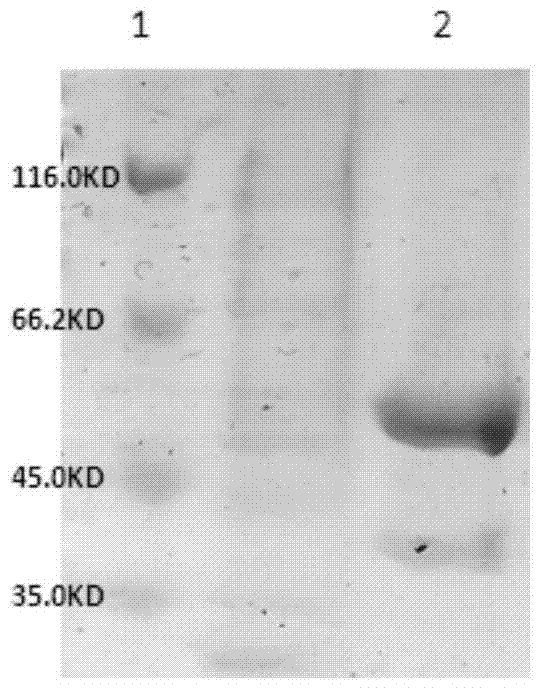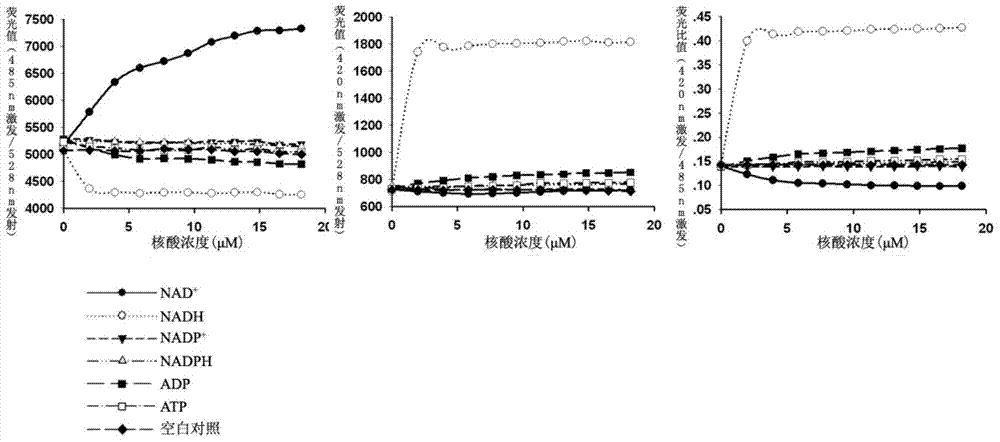Gene-encoded nicotinamide adenine dinucleotide fluorescent probe and its preparation method and application
A fluorescent probe and nucleotide sequence technology, applied in the ratio of NAD+ and NADH/NAD+, recombinant fluorescent fusion protein detection probe, preparation of the above-mentioned detection probe, detection of NADH field, can solve the problem that cannot be applied to live animals Or cells, NAD(H) measurement inconvenience, NADH easy to oxidize and other problems
- Summary
- Abstract
- Description
- Claims
- Application Information
AI Technical Summary
Problems solved by technology
Method used
Image
Examples
Embodiment 1
[0113] Example 1pRSET b Construction and expression of -ydiH(189)-YFP-ydiH(190)
[0114] 1. Amplify the nucleic acid sequence of cpYFP:
[0115] Using pMD19-cpYFP as a template, use primers cpYFP F and cpYFP R to amplify the coding sequence of yellow fluorescent protein (cpYFP). The primer sequence (primers were synthesized by Shanghai Sangon Bioengineering Co., Ltd. (Shanghai, China)) is as follows:
[0116] P1: PstI GAAT CTGCAG GCTACAACAGCCACAACGTCTATATC (SEQ ID NO: 29)
[0117] P2: KpnICCAAGCTTCGG GGTACC GTTGTACTCCAGCTTGTG (SEQ ID NO: 30)
[0118] The PCR reaction system is
[0119]
[0120] The PCR reaction conditions are:
[0121]
[0122] The PCR amplification product was electrophoresed in 1% agarose gel for 20 minutes to obtain a cpYFP fragment of about 750bp. The cpYFP fragment was recovered and purified from the gel using the Shanghai Sangon DNA Fragment Recovery and Purification Kit (Shanghai Bioengineering Co., Ltd., Shanghai, China) according to the...
Embodiment 2
[0159] Example 2. ydiH(189)-YFP-ydiH(190) derived series probes
[0160] Probe construction principle
[0161] construct pRSET using b The intermediate transition plasmids of -ydiH(189)-YFP-ydiH(190) and other probes were used as templates, and the derivative series of probes were constructed according to the principle of site-directed mutagenesis.
[0162] Construction of mutant library
[0163] 1. Primer design (Shanghai Sangong)
[0164]
[0165]
[0166] 2. PCR amplification
[0167] Truncation and site-directed mutagenesis were performed using site-directed mutagenesis PCR.
[0168] Mutant PCR amplification system (primers, enzymes, dNTPs, etc. are from Fuzyces Co.):
[0169]
[0170] 3. Separation and purification of DNA fragments
[0171] DpnI digestion
[0172] Firstly, the above PCR amplified fragment was treated at 37°C for 3 hours with DpnI enzyme (from Fuzyces Co., Ltd.) in order to remove potential template plasmid contamination. Then, the reactio...
Embodiment 3
[0182] Example 3 Fluorescent Probes for the Ratio of Reduced and Oxidized Nicotinamide Adenine Dinucleotide Determination of Changes in NADH / NAD+ Ratio
[0183]The structure of the reduced and oxidized nicotinamide adenine dinucleotide ratio fluorescent probe is that cpYFP is inserted between the amino acids F189 and L190 of Trex. The sequence of this probe is SEQ ID NO: 148, and the preparation method is the same as Example 2. The probe is only for NADH and NAD + There is a response, but there is no response to NADH analogues. When using 485nm excitation, it can be found that the combination of NAD and NADH can lead to the enhancement of the 528nm emission fluorescence of the probe, but using 420nm excitation, only the combination of NADH can cause the probe to respond. Since the probes are excited at 420nm and 485nm, both can emit fluorescence at 528nm, so using different wavelengths of fluorescence excitation, measuring the intensity ratio (420nm / 485nm) of the two emission...
PUM
| Property | Measurement | Unit |
|---|---|---|
| molecular weight | aaaaa | aaaaa |
Abstract
Description
Claims
Application Information
 Login to View More
Login to View More - R&D
- Intellectual Property
- Life Sciences
- Materials
- Tech Scout
- Unparalleled Data Quality
- Higher Quality Content
- 60% Fewer Hallucinations
Browse by: Latest US Patents, China's latest patents, Technical Efficacy Thesaurus, Application Domain, Technology Topic, Popular Technical Reports.
© 2025 PatSnap. All rights reserved.Legal|Privacy policy|Modern Slavery Act Transparency Statement|Sitemap|About US| Contact US: help@patsnap.com



